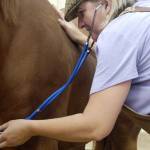Colic Surgery and Postoperative Ileus in Horses

Studies indicate that about four to 10 out of every 100 horses can be expected to colic each year. Many mild cases of equine colic resolve without treatment, and even more severely affected horses can often be helped with pain medications, hydration, and other supportive care. For some colics, however, surgery is the only treatment.
When a horse needs this very serious surgery, owners need to consider cost, the physical demands of the procedure on the horse, care during the recovery period, and the risks of both the surgery and the hours and days immediately after the operation. One of the most serious complications of abdominal surgery in horses is postoperative ileus, a condition in which the intestines react to the shock of surgery by failing to regain motility. Gut contents cannot be moved, gas builds up, and tissues can die, leading to a second surgery and sometimes a fatal outcome if the condition can’t be reversed.
No one knows the cause of postoperative ileus, which occurs in an estimated 10 to 50% of equine surgical colic cases. Of these horses, up to 80% may die or be euthanized. Recent research suggests there is a significant inflammatory component to postoperative ileus, possibly triggered by unavoidable handling of the horse’s intestines during surgery. Researchers have also learned that intestinal macrophages, the specialized white blood cells that rid the body of damaged tissue, and mast cells likely play a role in developing and maintaining ileus.
The diagnosis of postoperative ileus is not always straightforward, as most horses will naturally show some signs of discomfort after abdominal surgery. Pain also could be due to mechanical obstructions or other surgical complications. Besides signs of mild to severe colic, several important criteria for a diagnosis of ileus are heart rate remaining above 40 beats per minute; evidence of a fluid-distended small intestine on rectal examination or ultrasound; and four or more liters of nasogastric reflux on a single intubation or more than two liters on each of several repeated intubations.
Treatment options for postoperative ileus may include one or more therapies including nasogastric decompression, administration of fluids and electrolytes, medications to prevent endotoxemia and other infection, management of pain and inflammation, and use of lidocaine or another drug that facilitates the bowel in moving its contents (prokinetics). Offering the horse something to eat as soon as possible during the recovery period is helpful in preventing or lessening the severity of postoperative ileus, and hand-walking is also suggested as soon as the horse is able to move with coordination.
The use of carboxymethylcellulose, an intestinal lubricant, is somewhat controversial because of conflicting research reports as to whether it reduces or increases the chance of adhesions after abdominal surgery. There are also mixed opinions on whether a second surgery is beneficial. This option can sometimes locate the problem and correct blockages, but there is the potential for more harm to the horse that is already challenged. There is some evidence that horses undergoing a second colic surgery soon after the initial procedure have a reduced survival rate and more complications during recovery.








